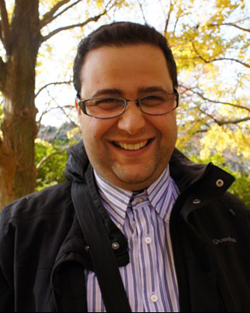Postgraduate students
Danilo Giambra BA MA
Mediated Representations: Japanese New Religions and Social Media
Social Media significantly affect the way religion is presented and represented online, and allow a variety of religious actors to create a new type of charismatic authority for themselves, similar to that of celebrities. Drawing on examples derived from the use of the Internet by two established Japanese New Religions, Tenrikyō and Seichō no Ie, I argue that even where religious movements are resistant to using this medium at the organization level, new interactive digital spaces are changing the way religion is communicated online. This is because the agency of individuals and groups linked to the movement in these environments often overlaps with that of the organization itself, as a result of how meaning-making and public representation work on these platforms. For religious organizations which actively promote their use, Social Media provide ways to reinforce the authority of their current leadership despite the potential for harsh and undermining criticism opened up by these new spaces. That is, Social Media make available new tools and features that allow religious leaders to construct celebrity-like personae on these platforms, where the divide between their social roles of private persons and religious leaders is made thinner by the strategies of presentation, the effect of mediation, and the interactive nature of the Presentational Media.
Communication is a fundamental element of religion. There would be no religion at all, if religious actors were not able to communicate their ideas and their beliefs, if they were not empowered to share their experiences and their interpretations of the world we live in. Communication is not just an effective tool for teaching doctrines and gaining new adherents; more often, it is evident that communication plays an active religious function, which can be justified from within the theology of the religious movement. It is therefore important to understand how Social Media are changing the way religious actors communicate through the Internet. Communicating religion through potentially interactive and collaborative channels does influence how religion is presented, represented, and transformed online, often despite the official policies of the religious movements involved. Unlike so-called traditional media, social spaces built in the Web 2.0 and beyond present characteristics of their own, which have altered how users get access to religious information, materials, and experiences, as well as what they can do with them. Because of their immediacy, Social Media have proven to be flexible digital environments, where religious information can be shared right here and right now. Moreover, the information is potentially subjected to the immediate and active attention of other users, who, in turn, are able to comment on it and re-share it in other platforms as well. That is, these environments also provide a space where religion can be enacted, and not just discussed.
Japanese New Religions (shinshūkyō 新宗教) have been noticeably affected by this change. Whether these organizations seek to resist or to harness the use of Social Media at the organization level, Social Media have opened new spaces where religion can be discussed and enacted. In this thesis I draw on examples taken from Tenrikyō and Seichō no Ie, as these movements can be considered representative of the two general tendencies underlined above. In other words, Tenrikyō has been shown to be resistant to the use of Social Media, at least insofar as its central religious bureaucracy and its policies are concerned. By contrast, Seichō no Ie has been actively involved at the organization level in implementing new communication technologies, including new Internet-based platforms, where social interactivity is paramount. In both cases, new interactive digital spaces have been shown to have a noticeable effect on religious communication. That is to say, Social Media have empowered various religious actors of Tenrikyō with a voice and the possibility of creating multiple mediated representations of the group in these interactive digital environments, regardless of the general attitude (and policy) of the organization on the matter of using such media for communicating religion online. By comparison, Seichō no Ie’s President, Taniguchi Masanobu, was able to use these presentational platforms to his advantage, creating a religious persona online with characteristics similar to those of celebrities, alongside the active effort of his organization and staff to promote Social Media for communicating and practicing religion.
The effect of Social Media on Japanese New Religions is also connected with how the movement is officially structured offline, how its leadership is organized and represented publicly, and its level of internationalization. Yet, the impact of Social Media on Japanese New Religions is significant and is likely to become even more so in years to come.
Supervisors: Dr Erica Baffelli and Dr Will Sweetman